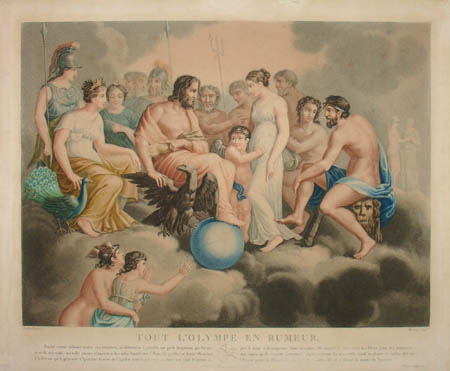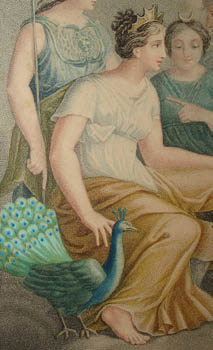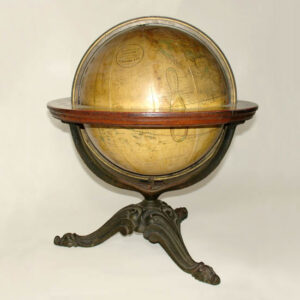Description
Although the print is attributed to Raphael in the lower margin credit, it is unknown exactly which original work this might be based on. It is possible that the print was loosely based on Raphael’s work at Villa Farnesina in Rome. Raphael’s cycle of frescoes there depict the story of Cupid and Psyche including a large painting of the pair visiting the Council of the Gods. Nevertheless, that composition is different than this print other than some similar features such as the globe, eagle, and peacock. It is also possible that the print might be based on a work that was attributed to Raphael in the 19th century, but since reattributed to another painter, or on a sketch by Raphael that was never realized as a painting, or that like some other frecoes produced by Raphael and his assistants, the original was later painted over and no longer exists.
According to the myth, Psyche, daughter of a king, is a maiden so lovely that she has become famous throughout the land and admirers travel to worship her beauty. Venus, feeling neglected by worshippers and jealous of her mortal rival, sends her son Cupid to earth to place a curse on Psyche. Instead he falls in love with her, and Psyche with him. This leads to further vengeance from Venus, and a series of events in which both Cupid and Psyche suffer, finally resulting in Venus imprisoning Cupid. He escapes, collects Psyche, and, as shown in this print, the two lovers finally decide that enough is enough, and fly up to Mount Olympus to appeal to Jupiter to intervene and make sure Venus does not cause any further trouble. Jupiter agrees and calls an assembly of the gods and goddesses where he announces he will confer immortality on Psyche and thus make her a goddess. This suits Venus, because Psyche will no longer be distracting men on earth, and the story ends happily with the marriage of Cupid and Psyche–whose names literally mean Love and Soul.
Text in French in the lower margin explains the scene:
Psiche voyant echouer toutes se tentatives, se determine a prendre un parti dangerous, que lui impose la necessite: ira-t-elle encore s’exposer a des refus humiliants? Non, elle prefere se livrer elle-meme a la Deesse qui la poursuit. Cependant la mere de Cupidon nourrissait toujours dans son Coeur la meme esprit de haime et de vengeance: dans sa colere; elle importune sans cesse les Dieux pour les interesser a une injure qu’elle resent si vivement. Jupiter entoure des immortels, recoit sa plainte au milieu des airs. L’Amour prend la defense de son amante, et intercede en sa faveur le maitre du Tonnerre.
Rough translation: Psyche seeing that all her attempts have failed, is determined to take a dangerous course of action, which necessity imposes on her: will she still be exposed to a humiliating refusal? No, she prefers to speak in person to the Goddess who pursues her. However, the mother of Cupid continues to nourish the same spirit of hatred and vengeance in her heart: in her anger; she unceasingly importunes the Gods to consider the insult that she resents so highly. Jupiter, surrounded by the immortals, receives her complaint in the midst of the sky. Cupid takes the defense of his lover, and the Master of Thunder intercedes in her favor.
Raphael was one of the three greatest artists of the Italian High Renaissance and an accomplished architect as well. As chief archeologist to the Pope, he was involved in the excavation of the ancient Golden House of Nero, and adapted many of the elaborate Roman frescoes he saw there in creating his own innovative painted wall and ceiling designs in the Vatican and private villas in Rome. Prints made after Raphael’s drawings, designs and paintings were produced during his lifetime by the engraver Marcantonio Raimondi (c.1470-1482 – c. 1527-1534). Raphael prints by other engravers were especially popular in the neoclassical period of the mid 18th century and early 19th century coinciding with the tremendous revival of interest in the classical art of ancient Greece and Rome, as well as the classicism of the Renaissance. Some of these prints served as references for architects and designers because many were based on frescoes that had been incorporated into interior architecture. This interest in Raphael, often reflected in prints, continued throughout the 19th century as he achieved legendary status.
Among the more famous prints after Raphael are series from the late 18th century illustrating his frescoes in the Vatican stanze (notably Picturae Raphaelis Sanctii Urbinatis,Rome: 1722); the Vatican loggia (notably Loggia di Rafaele nel Vaticano, Rome: 1772-77) and the Villa Farnesina in Rome (notably Psyches et Amoris Nuptiae ac Fabula, Rome: 1693). One popular set, variously issued as engravings and lithographs during the 19th century, shows details of Raphael’s allegorical frescoes of 12 hours of the day and night. A related set of engravings depicts the gods and goddesses of the Roman pantheon riding in chariots in their heavenly domain, probably representing the seven days of the week.
The engraver is identified on the print only as “Mariage.” This probably refers to Louis-François Mariage, a French engraver active during the First Empire.
Condition: Generally very good with the usual light toning, wear, soiling, soft creases. Some light discoloration and pale foxing to margins. Platemark about even with bottom edge, possibly as issued; other sides with ample margin beyond platemark. Bottom edge slightly irregular.
Reference:
Hamilton, Edith. Mythology. New York: Mentor Books: 1942. pp. 92-100.








